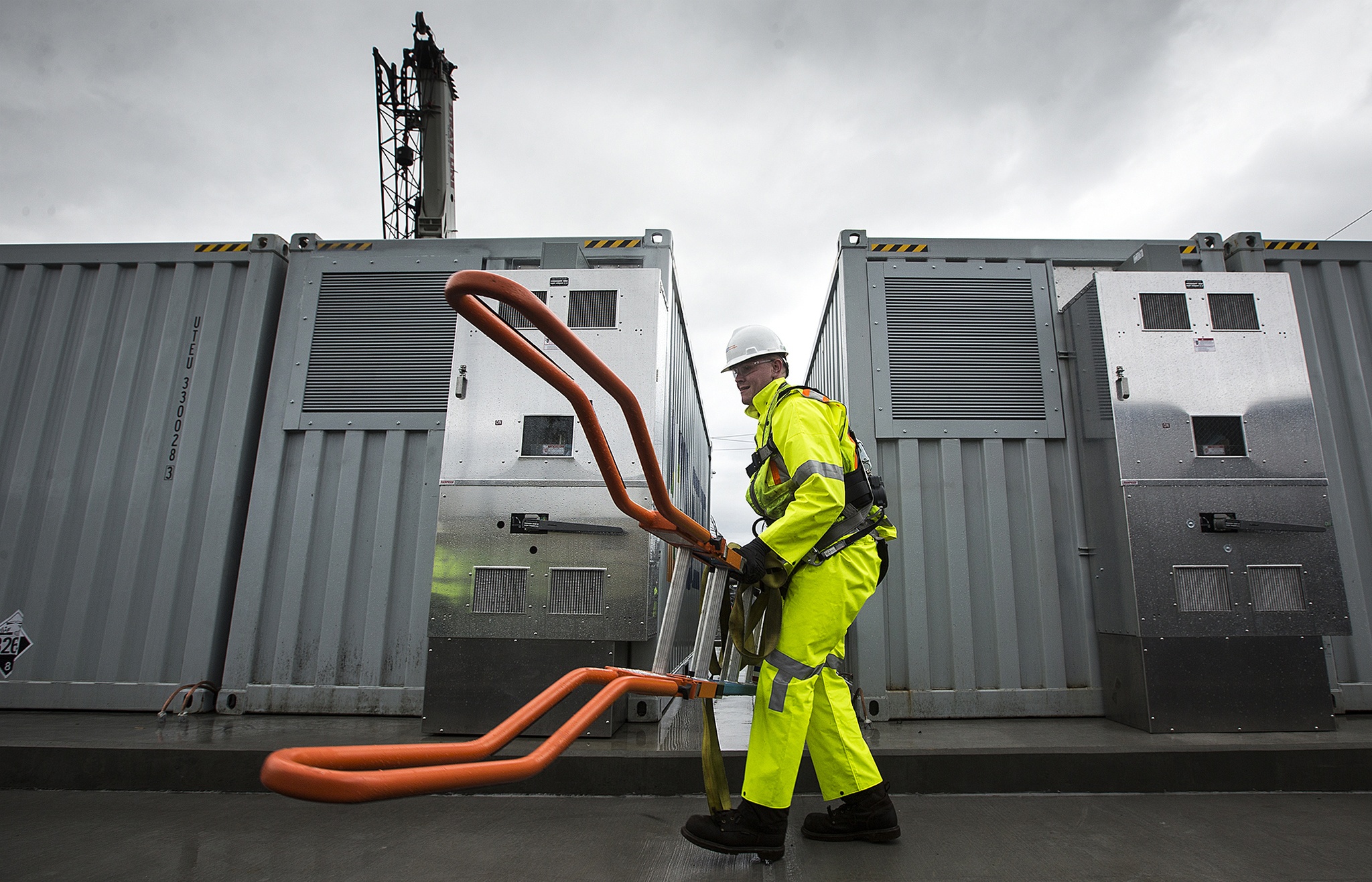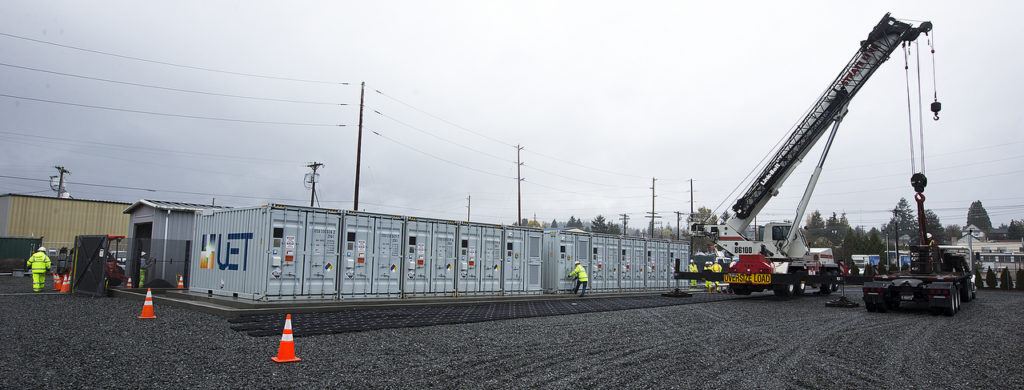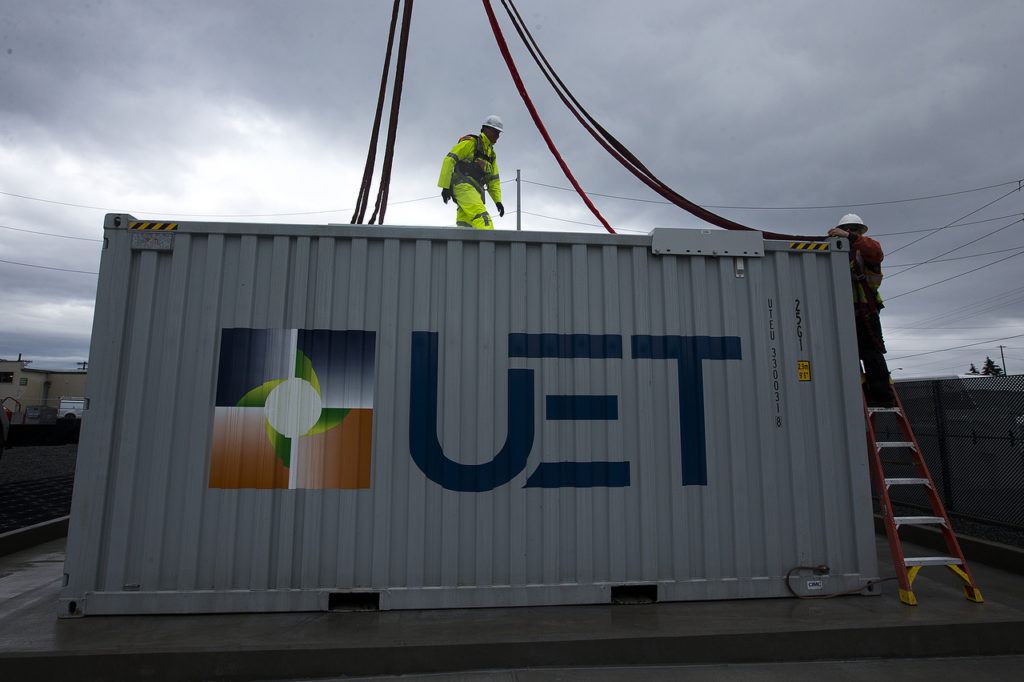EVERETT — Don’t be deceived: They look like shipping containers. But the rows of massive metal boxes could contain the utility industry’s future.
At least, that’s the hope of officials at the Snohomish County Public Utility District, which is installing a huge battery system near downtown Everett. The district’s goal for the $11.2 million project is to make energy storage cheaper and more flexible for utilities.
“This is primarily a research-and-development project, but it has significant value for not only the PUD but the entire industry,” district spokesman Neil Neroutsos said.
The project, dubbed MESA 2, consists of a vanadium battery system powerful enough to keep the lights on in as many as 1,000 homes for eight hours. The system, which takes up 20 shipping containers, is made by Mukilteo-based UniEnergy Technologies. The software system connecting the battery to the PUD’s grid is made by Seattle-based Doosan GridTech, formerly known as 1Energy Systems.
After MESA 2 comes on line in the spring, the PUD and industry partners expect to use it to learn how to better use energy storage systems. The district’s MESA 1 project is already yielding test results that district officials hope will enable utilities to more efficiently use battery storage.
The projects are part of the PUD’s effort to spur innovation of energy storage technologies, making them easier and cheaper for utilities to use. Since 2011, the district has awarded several contracts, which combined are worth more than $20 million, to project lead Doosan GridTech for energy storage and related projects. That total includes more than $7 million in grants from the state’s Clean Energy Fund.
Most of those contracts were given without competitive bidding to Doosan GridTech, which was started by a former PUD employee. That close relationship sparked a whistleblower complaint and investigation in 2015, which found that the PUD failed to avoid the appearance of a conflict of interest.
Storing energy lets utilities make better use of it. In places where energy costs spike during peak demand times, a utility can buy energy when demand and the price are low, and store it. When demand goes up, it can turn on its batteries.
Peak pricing is not a major issue in the Pacific Northwest, which mostly relies on hydroelectric dams and has among the cheapest electricity costs in the country, according to the federal Department of Energy.
Energy storage can still benefit utilities in Washington, where the state is a strong supporter of clean tech initiatives, by enabling more flexible and efficient use of resources, Neroutsos said. It can help “more closely match generation with demand.”
For example, wind turbines generate power only when the wind blows. If that happens at night, a utility might not be able to use the energy because demand is low. An energy storage system allows a utility to park the energy until the morning, when demand shoots up.
The systems also allow for more efficient use of energy by limiting voltage loss during transmission, Neroutsos said. They “give us more flexibility in how we manage our grid.”
Another goal of PUD’s energy storage effort is to encourage others to adopt a set of open standards for connecting battery systems to power grids called the Modular Energy Storage Architecture, or MESA.
Currently, energy storage systems are expensive black boxes. Each vendor has a proprietary design. That means utilities have to buy the entire system, rather than assembling their own using components from different vendors.
Adopting open standards could help make the systems more affordable and easier to use, according to PUD officials.
The project offers UniEnergy Technologies an opportunity to further test and improve its vanadium batteries. The company’s batteries are in Avista Utilities’ energy storage system in Pullman, which went live last year.
“The MESA 2 project is critical to the further scaling up of UET’s deployments and manufacturing,” said Russ Weed, the company’s vice president of business development and marketing.
Vanadium batteries offer several benefits over lithium batteries: They can’t catch on fire, can be recycled and can discharge all of their stored energy, he said.
While producing batteries for Avista and the PUD, UniEnergy has “substantially improved the performance of its systems, reduced their price by about 50 percent, won contracts in multiple states and countries, expanded our service offerings, and scaled up our production capacity,” Weed said.
Dan Catchpole: 425-339-3454; dcatchpole@heraldnet.com; Twitter: @dcatchpole.
Talk to us
> Give us your news tips.
> Send us a letter to the editor.
> More Herald contact information.



























